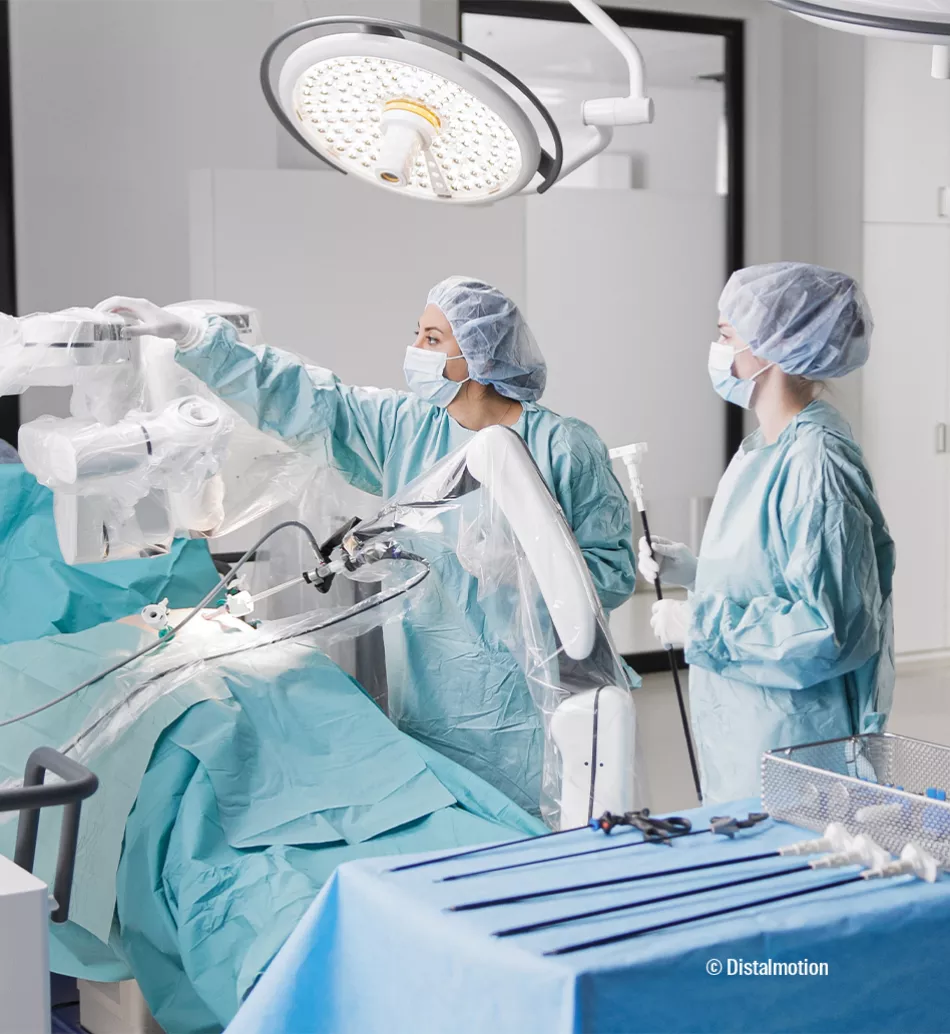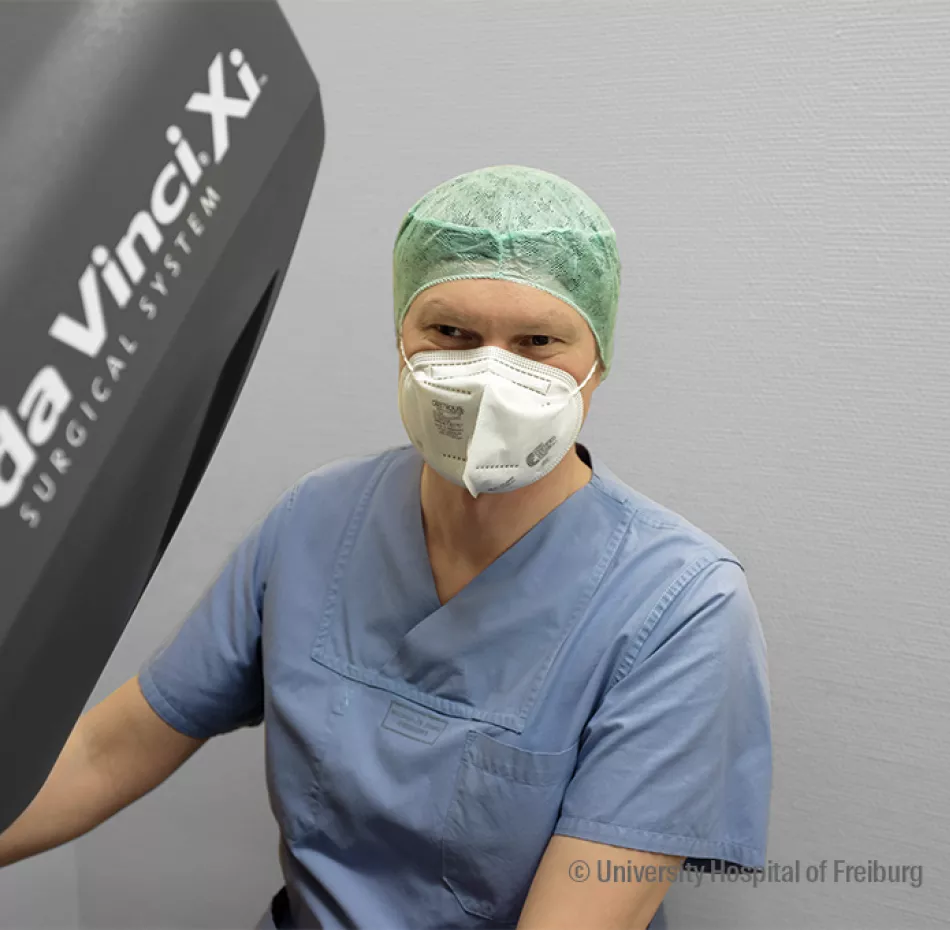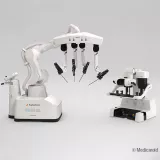“Without robots, medical progress could be hindered”

How does robotics change a surgeon’s job ? CONNECTED has asked professor Hannes Neeff, deputy chief medical officer of the University Hospital of Freiburg (one of the largest in Germany). A specialist in visceral surgery and surgical oncology, he regularly operates with the assistance of Da Vinci and he is training young surgeons to use the robot.
An interview with Professor Hannes Neeff
Professor Neeff, what are the benefits of robotics for surgery?
[Pr Hannes Neeff]
In my case, it is mostly accessibility and easy handling in limited operating space – the pelvis, for instance. To be able to reach these areas, often large incisions are necessary. On the other hand, if we can use minimal invasive surgery (laparoscopy), handling and freedom of movement are often limited. The instrument mounted on a robotic arm has a wider articulation angle than a human hand or a laparoscopic instrument. I can easily access small spaces and bypass obstacles, such as bones or other organs.
How about precision?
The robot stabilizes movements and makes it possible to operate with a very high degree of precision. It also stabilises the field of vision, which is even more beneficial for me personally.
How come?
The camera is held by the robot, so the image is stable. It is guided by me, I know where it goes. In classical laparoscopy, our “eyes ” are held by an assistant. It is less stable and there is a delay compared to what we would like to see. We need to guide the assistant – “More to the left, higher…” If the assistant is not well-trained or doesn’t know you well, it can be tiring and even make you sea-sick.
The robot brings you comfort…
A great deal of comfort indeed. The most important is position: with the console, we work sitting upright, instead of standing, bent over the operating table. Just imagine the difference it makes for a six to eight-hour operation! With the robot, ergonomics are a million times better… but many surgeons do not like to mention it because it is not a genuinely medical benefit. You can hardly convince someone to pay for the surgeon’s comfort. Therefore, this criterion has been rather neglected until now in the “for-or-against-the-robot” debate. I hope it will be better recognized in the future.
You’ve said that the system helps you to see better. On the other hand, you lose the sense of touch…
Indeed, there is no tactile feedback. It will be interesting to see if the manufacturers manage to implement it. However, I don’t miss it and it was much easier to adapt than I had thought. When a surgeon pulls on a tissue with tweezers, he knows by experience when it will be torn. The visual feedback compensates for the absence of tactile feedback.
You are also cut off from your team – staying apart, eyes firmly fixed on your glasses… Some say that this can cause emotional distance, which is a problem, since a successful operation also depends on the complicity between the healthcare team members.
You may feel somewhat alone with the console, it is true. The system is of course designed to make up for this, by enabling constant communication with the team. Directional microphones and speakers transmit whatever is being said – I can even hear the others whisper. Indicator lights show which tools are active. The screens show the others what I am doing and an arrow on my screen shows me what the others want me to see. And if I feel lonely, I use short breaks – for example when changing an instrument – to reconnect to people for a chat.
Does training in surgical robotics further extend the surgeons’ already lengthy training?
Not really. We surgeons are handymen and we already learn about a multitude of movements and instruments. Moreover, the systems are designed to render our usual movements (rotation of the wrist, pinching with two fingers…), so sensations are quite natural.
Controlling the switches is less intuitive. You need to be able to use them without looking, because the robot stops as soon as you look up. But it can be learnt quickly. Have you seen how fast children learn to use a new game console? It is the same! (chuckles). Young surgeons are used to joysticks, screens or even 3D environments. They are naturals. And they do not complain about having to use a robot, they want to learn.
Will robotics become a standard?
In the early nineteen-nineties, laparoscopy was also expensive and training the whole team was required. Still, it became generalised.
Today, some of my young colleagues do not even know how an “old-fashioned” appendectomy used to be done! Robotic assistance will follow the same path.
In spite of the high costs of the equipment, the consumables and maintenance?
Comprehensive and very expensive, the Da Vinci was the only approved solution in Germany for a long time, as in other countries. But, the more simple and accessible solutions will be available, the sooner the technique will become a standard. Some hospitals will have high-end technology, some others will adopt more limited solutions - such as an arm to hold the camera – but in 10 to 20 years from now, they will all have a robot. Working without them would mean foregoing medical progress. Robotics will soon be widely used in laparoscopy and in all operations difficult to access. In my hospital, there are already certain types of procedures which are conducted only with robots. For instance, I wouldn’t operate a regular low rectal carcinoma without a robot. Robotic assistance would also be useful for small procedures – hernia, appendicitis, gall bladder – but almost no one uses it.
Why?
Because the decision to use robotic assistance is based on the cost-medical benefit ratio. In the case of such small procedures, like easy-access operations, the robot’s extra cost is not “ cost-effective”.
… even if there is greater precision?
The robot’s real benefit for the patient – a shorter stay in hospital, fewer complications, or recurrences – has not been scientifically proven. Besides, it would still be difficult to prove, because the efficiency of a surgical intervention depends on a combination of factors – the healthcare staff, medication, equipment, methods… how do we know what the robot’s contribution is ?
Is it important to know it exactly?
Patient benefits are often considered by those who pay for it – in particular insurance companies. The question they ask is “Why pay more, if the benefits are not proven? ”
In other fields, robots save time and money by replacing humans…
A robotised operation often requires fewer assistants since the robot holds the camera and tools. So, the economic calculation “More robots, lower salary costs ” will perhaps be considered in the future. However, fewer surgeons is not an option that we, surgeons, like to consider!
What will future solutions be like?
Current technologies (arms, instruments, interfaces…) will progress. Tactile feedback will enable surgeons to better “feel” their movements. Augmented reality will provide an improved overview of the operating field – for instance by indicating the location of a tumour. New technologies will be integrated: artificial intelligence and machine learning will process masses of physiological and operational data, they will recognise recurring patterns, help surgeons to prepare the procedures. On the other hand, I don’t see machines handling surgical instruments on their own.
Why?
When operating, it is not always a question of life or death, but almost. Every incision, even small, may have serious consequences. And every incision is much more than a technical task: it is the result of instant decision-making, involving a value judgement. An operation is in fact a series of instant value judgements.
… like driving a car…
Yes, but we realise that autonomous vehicles are progressing much slower than we thought. And, to me, decisions taken during a surgical intervention are more complex and subjective. We decide to make an incision here to avoid damaging something there. We must often choose between two negative consequences : we cut a nerve and with it the tumour is gone, fine, but bladder function will be affected. To expect a machine to make such a decision is a bit like, in case of an inevitable crash, expecting an autonomous vehicle to make a split-second decision to run over a child or a grandmother. It will take a lot longer before a machine will be capable of such a decision or before a human being will let a machine take such decisions.
Will robots then stay ” simple” assistants ?
Surgical robots in movies – which draw a diagnosis and operate all on their own – will continue to belong – for a long time - to the world of science-fiction. That said, short-term progress in medical robotics is highly promising and I look forward to discovering it.

Professor Hannes Neeff
with the console of a Da Vinci.
Sitting upright – much more comfortable than standing and bent over the operating table, as required by classical surgery.

